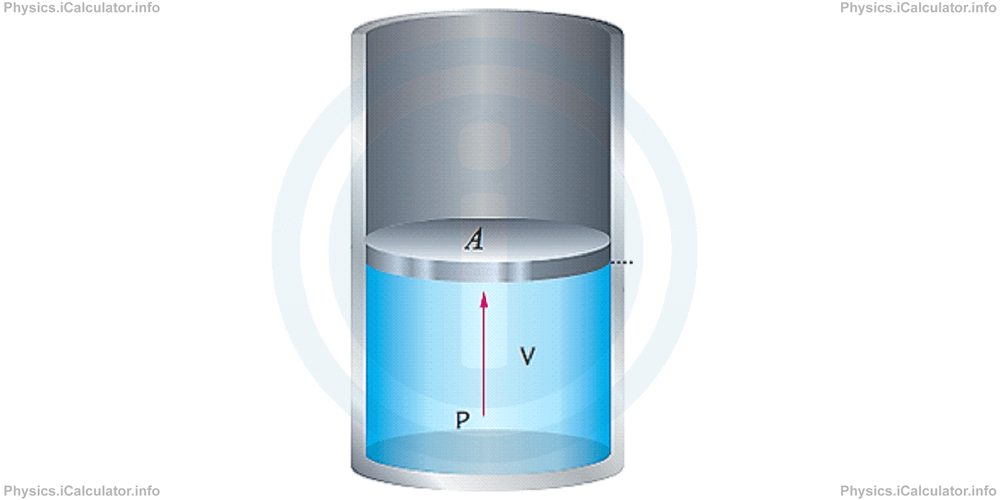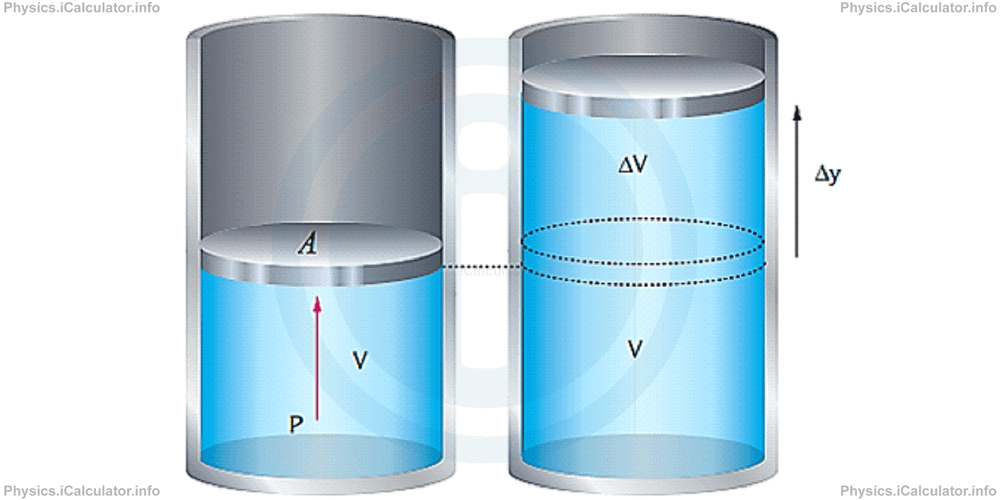Menu
Physics Lesson 13.6.4 - Work in a Thermodynamic Process
Please provide a rating, it takes seconds and helps us to keep this resource free for all to use
Welcome to our Physics lesson on Work in a Thermodynamic Process, this is the fourth lesson of our suite of physics lessons covering the topic of The Kinetic Theory of Gases. Ideal Gases, you can find links to the other lessons within this tutorial and access additional physics learning resources below this lesson.
Work in a Thermodynamic Process
Let's find an expression for calculation of the work done by a gas during a slow thermal process. Consider a cylinder filled with gas with a freely moveable piston above it as shown in the figure below.

Since the piston moves freely, the gas pressure remains constant because it is balanced from the atmospheric pressure, i.e. the pressure exerted by the air from above the piston. The work done by the gas to raise the piston by Δy as shown in the figure below, is

Given that
we have
=Pgas × (Apiston × ∆y)
=Pgas × ∆V
This expression gives the left part of the ideal gas law formula.
The formula indicates that:
Volume decreases ⇒ ΔV < 0 ⇒ Wby gas < 0
Volume constant ⇒ ΔV = 0 ⇒ Wby gas = 0
as we discussed earlier.
Example 4
12 g of helium gas is heated from 20 ºC to 100 ºC, at a constant pressure. What is the work done by helium during the heating process? (Take MHe = 4 g/mol)
Solution 4
First, let's write the clues to create a clearer idea about the situation. We have:
m = 12 g
M = 4 g/mol
t1 = 20°C
t2 = 100°C
P1 = P2 = P
Wby gas = ?
From the first two clues we can work out the number of moles, n. We have:
= 12 g/4 g/mol
= 3 moles
Also, from the next two clues, we obtain the change in temperature:
= 100°C - 20°C
= 80°C
= 80 K
Applying the ideal gas law for the two given instants (states) 1 and 2, we obtain
and
Subtracting the first equation from the second, we obtain
or
The first part of the last equation gives the work done by the gas. Therefore, the left part will also give the work done by the gas. Hence, we can write:
= 3 moles × 8.31 J/mol × K × 80 K
= 1994.4 J
This result means helium does 1994.4 J of work against the environment during thermal expansion.
You have reached the end of Physics lesson 13.6.4 Work in a Thermodynamic Process. There are 6 lessons in this physics tutorial covering The Kinetic Theory of Gases. Ideal Gases, you can access all the lessons from this tutorial below.
More The Kinetic Theory of Gases. Ideal Gases Lessons and Learning Resources
Whats next?
Enjoy the "Work in a Thermodynamic Process" physics lesson? People who liked the "The Kinetic Theory of Gases. Ideal Gases lesson found the following resources useful:
- Work Feedback. Helps other - Leave a rating for this work (see below)
- Thermodynamics Physics tutorial: The Kinetic Theory of Gases. Ideal Gases. Read the The Kinetic Theory of Gases. Ideal Gases physics tutorial and build your physics knowledge of Thermodynamics
- Thermodynamics Revision Notes: The Kinetic Theory of Gases. Ideal Gases. Print the notes so you can revise the key points covered in the physics tutorial for The Kinetic Theory of Gases. Ideal Gases
- Thermodynamics Practice Questions: The Kinetic Theory of Gases. Ideal Gases. Test and improve your knowledge of The Kinetic Theory of Gases. Ideal Gases with example questins and answers
- Check your calculations for Thermodynamics questions with our excellent Thermodynamics calculators which contain full equations and calculations clearly displayed line by line. See the Thermodynamics Calculators by iCalculator™ below.
- Continuing learning thermodynamics - read our next physics tutorial: Pressure, Temperature and RMS Speed
Help others Learning Physics just like you
Please provide a rating, it takes seconds and helps us to keep this resource free for all to use
We hope you found this Physics lesson "The Kinetic Theory of Gases. Ideal Gases" useful. If you did it would be great if you could spare the time to rate this physics lesson (simply click on the number of stars that match your assessment of this physics learning aide) and/or share on social media, this helps us identify popular tutorials and calculators and expand our free learning resources to support our users around the world have free access to expand their knowledge of physics and other disciplines.
Thermodynamics Calculators by iCalculator™
- Carnot Engine Efficiency Calculator
- Entropy Calculator
- Gas Laws Calculator
- Molecular Mean Free Path Calculator
- Translational Kinetic Energy Of Gas Calculator
- Root Mean Square Speed Calculator
- Ideal Gas Law Calculator
- Change In The Gas Internal Energy Calculator
- Radiative Heat Transfer Calculator
- Evaporative Heat Transfer Calculator
- Convective Heat Transfer Calculator
- Conductive Heat Transfer Calculator
- Final Temperature Of Mixture Calculator
- Heat Absorbed Or Released Calculator
- Thermal Expansion Calculator
- Temperature Calculator